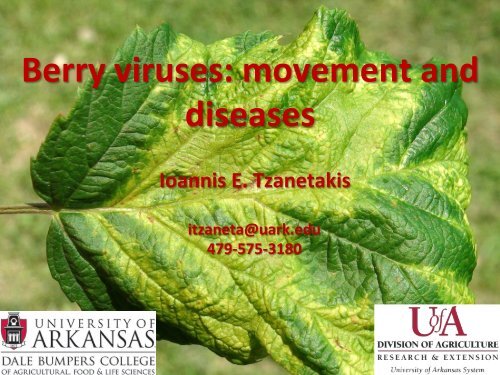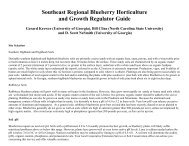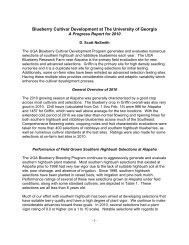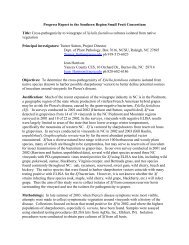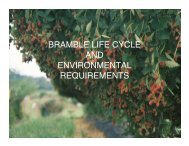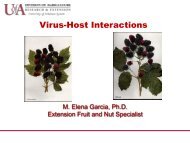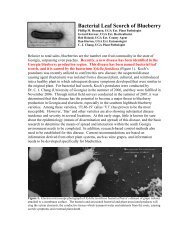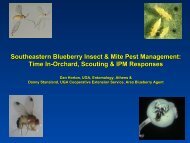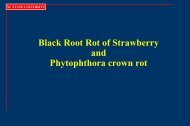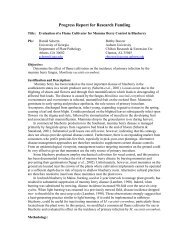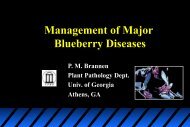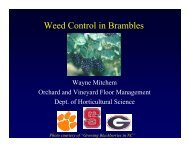Berry viruses - The Southern Region Small Fruit Consortium
Berry viruses - The Southern Region Small Fruit Consortium
Berry viruses - The Southern Region Small Fruit Consortium
You also want an ePaper? Increase the reach of your titles
YUMPU automatically turns print PDFs into web optimized ePapers that Google loves.
<strong>Berry</strong> <strong>viruses</strong>: movement and <br />
diseases <br />
Ioannis E. Tzanetakis <br />
itzaneta@uark.edu <br />
479-‐575-‐3180
Virus transmission 101
Phylum Arthropoda, Class Insecta, Order Hemiptera
Phylum Arthropoda, Class Insecta
Phylum Arthropoda, Class Arachnida, Order Acariformes
Phylum Nematoda, Class Secernentea, Order Tylenchida <br />
Nematodes
Kingdom: Fungi <br />
Phylum: Chytridiomycota <br />
Class: Chytridiomycetes <br />
Order: Incertae sedis <br />
Family: Olpidiaceae <br />
Genus: Olpidium
Kingdom: Rhizaria <br />
Phylum: Cercozoa <br />
Class: Plasmodiophorea <br />
Order: Plasmodiophorida <br />
Family: Plasmodiophoridae <br />
Genus: Polymyxa
Vectors and plant <strong>viruses</strong> they transmit
Four modes of virus transmission
Strawberry <strong>viruses</strong> circa 2003 <br />
Arabis mosaic – Europe <br />
Tomato ringspot <br />
Raspberry ringspot – Europe <br />
Strawberry latent ringspot-‐Europe <br />
Tomato black ring –Europe <br />
Nematodes <br />
Strawberry crinkle <br />
Strawberry mild yellow edge <br />
Strawberry moIle <br />
Strawberry vein banding <br />
Aphids <br />
Fragaria chiloensis latent – Chile <br />
Tobacco streak* <br />
Pollen <br />
Strawberry pallidosis <br />
Beet pseudo-‐yellows <br />
Whiteflies*
Strawberry decline <br />
A $50M story
<strong>The</strong> whitefly <strong>viruses</strong>
BPYV-‐SPaV double infecTons
Other strawberry <strong>viruses</strong> <br />
Revisited strawberry virus-‐like diseases. <br />
ChloroOc fleck <br />
Leafroll <br />
Goal: IdenOfy unknown <strong>viruses</strong> that may contribute to the <br />
decline.
IdenTficaTon, characterizaTon and development <br />
of detecTon techniques for strawberry <strong>viruses</strong> <br />
* <br />
* <br />
* <br />
* <br />
* <br />
* <br />
* <br />
* <br />
* <br />
* <br />
* <br />
Tobacco streak virus <br />
Strawberry crinivirus 3 <br />
Strawberry crinivirus 4
No vector control
Vector control
Blackberry yellow vein disease <br />
First observed in 2000 in the Carolinas. <br />
Tested for known <strong>viruses</strong> (RBDV, TRSV etc) – Several <strong>viruses</strong> <br />
were found but none consistently associated with symptoms.
Tobacco ringspot virus and BYVD <br />
BYVD is very similar to what people thought as being TRSV <br />
symptoms <br />
TRSV textbook symptoms Single TRSV-‐infecOon <br />
Are symptoms cv. dependent <strong>The</strong> majority of plants <br />
infected with TRSV are symptomless
New <strong>viruses</strong> in Rubus in the last decade <br />
16 <strong>viruses</strong> & virus-‐like agents were known to infect Rubus <br />
before we started looking into Rubus complexes – We now <br />
have over 45… <br />
New Rubus <strong>viruses</strong> <br />
Blackberry yellow vein associated virus <br />
Blackberry virus E <br />
Blackberry virus X <br />
Blackberry virus Y <br />
Blackberry virus Z <br />
Beet pseudo yellows virus <br />
Blackberry yellow moAle virus <br />
Blackberry chloroBc ringspot virus <br />
Strawberry necroBc shock virus <br />
Black raspberry necrosis virus <br />
Raspberry leaf moAle virus <br />
Rubus canadensis virus -‐1 <br />
ImpaBens necroBc spot virus <br />
Raspberry latent virus <br />
etc…..
New <strong>viruses</strong> in Rubus in the last decade <br />
16 <strong>viruses</strong> & virus-‐like agents were known to infect Rubus <br />
before we started looking into Rubus complexes – We now <br />
have over 45… <br />
New Rubus <strong>viruses</strong> <br />
Blackberry yellow vein associated virus <br />
Blackberry virus E <br />
Blackberry virus X <br />
Blackberry virus Y <br />
Blackberry virus Z <br />
Beet pseudo yellows virus <br />
Blackberry yellow moAle virus <br />
Blackberry chloroBc ringspot virus <br />
Strawberry necroBc shock virus <br />
Black raspberry necrosis virus <br />
Raspberry leaf moAle virus <br />
Rubus canadensis virus -‐1 <br />
ImpaBens necroBc spot virus <br />
Raspberry latent virus <br />
etc….. <br />
Tests are available for all the new <strong>viruses</strong>
Same disease-‐different <strong>viruses</strong> <br />
AR MS NC
Arkansas <br />
BYVaV <br />
BVY <br />
TRSV
Carolinas <br />
BYVaV <br />
BVX <br />
BPYV <br />
INSV <br />
TRSV
Mississippi <br />
BYVaV <br />
TRSV <br />
BVE
How do we tackle BYVD <br />
Acer idenOficaOon of all (or almost all) <strong>viruses</strong> that are involved in <br />
the disease we need to: <br />
A. Make sure that mother plants are being tested for the new <br />
<strong>viruses</strong> before they are propagated. <br />
B. IdenOfy virus combinaOons that can cause BYVD. <br />
C. IdenOfy virus vectors. <br />
D. Find alternaOve hosts of the <strong>viruses</strong> in the field. <br />
E. Minimize or eliminate BYVD by eliminaOng the weakest link, the <br />
virus vector(s) that is the easiest to control.
What are the <strong>viruses</strong> present in your <br />
area <strong>The</strong> importance of detecTon <br />
• BYVaV -‐ MulOstate sample <br />
collecOon -‐ 35 isolates <br />
• i
What are the <strong>viruses</strong> present in your <br />
area <strong>The</strong> importance of detecTon <br />
• BYVaV -‐ MulOstate sample <br />
collecOon -‐ 35 isolates <br />
• i <br />
• DetecOon <br />
100% <br />
idenOty <br />
1 2 3 4 5 6 7 8 9
Virus interacTons: <strong>The</strong> BYVaV/BVY story <br />
BVY did not cause symptoms in single <br />
infecOons but together with BYVaV they <br />
cause BYVD. <br />
In mixed infecOons, BVY knocks down <br />
concentraOon of BYVaV to about 0.1% <br />
compared to Oter in single infecOons. <br />
In mixed infecOons, they can cause death <br />
of fruiOng canes. <br />
Susaimuthu et al.,2008. Plant Disease 92:1288-‐1292
Transmission <br />
Experiment Trialeurodes abutilonea Trialeurodes vaporariorum<br />
Experiment 1 4/7 3/9<br />
Experiment 2 5/8 1/8<br />
Experiment 3 3/10 3/10<br />
Total 12/25 7/27<br />
• Both whitefly species transmiIed the virus at a rate >30%
Alternate hosts <br />
Plant species Scientific name Family<br />
Number of plants<br />
tested<br />
Garden vetch Vicia sativa Fabaceae 16<br />
Virginia creeper Parthenocissus quinquefolia Vitaceae 16<br />
Red clover Trifolium pretense Fabaceae 16<br />
Wild garlic Allium vineale Amaryllidaceae 16<br />
Creeping woodsorrel Oxalis corniculata Oxalidaceae 16<br />
Carolina geranium Geranium carolinianum Geraniaceae 16<br />
Curly dock Rumex crispus Polygonaceae 16<br />
Dandelion Taraxacum officinale Asteraceae 16<br />
Tall fescue Festuca arundinacea Poaceae 16<br />
Wild wheat Avena fatua Poaceae 16<br />
Grapes Vitis vinifera Vitaceae 16<br />
Peach Prunus persica Rosaceae 16<br />
Blueberry Vaccinium spp. Ericaceae 16<br />
Shepherd’s purse Capsella bursa-pastoris Brassicaceae 16<br />
Nutsedge Cyperus spp. Cyperaceae 16<br />
Horsenettle Solanum carolinense Solanaceae 16<br />
Common ragweed Ambrosia artemisiifolia Asteraceae 16<br />
Tree of heaven Ailanthus altissima Simaroubaceae 16<br />
Apple Malus spp. Rosaceae 200<br />
Rose Rosa multiflora Rosaceae 40<br />
Carpetweed Mollugo verticillata Molluginaceae 16<br />
Amaranthus Amaranthus spp. Amaranthaceae 16<br />
Poor joe Diodia teres Rubiaceae 16<br />
Ground cherry Physalis spp. Solanaceae 16<br />
Sorghum Sorghum spp. Poaceae 16
Vector eliminaTon <br />
<strong>The</strong> BRNV paradigm <br />
New field monitoring <br />
Permanent tagged plants <br />
Time of transmission <br />
High incidence of virus <br />
PoIed plants <br />
Rotated every month <br />
P <br />
L <br />
H <br />
D <br />
O <br />
K <br />
G <br />
C <br />
N <br />
J <br />
F <br />
B <br />
M <br />
I <br />
E <br />
A
Average Aphids/Trap: 2004<br />
14<br />
110<br />
12<br />
100<br />
Average Aphids/Trap<br />
10<br />
8<br />
6<br />
4<br />
2<br />
90<br />
80<br />
70<br />
60<br />
50<br />
0<br />
4-May<br />
11-May<br />
18-May<br />
25-May<br />
1-Jun<br />
8-Jun<br />
15-Jun<br />
22-Jun<br />
29-Jun<br />
6-Jul<br />
13-Jul<br />
20-Jul<br />
27-Jul<br />
3-Aug<br />
10-Aug<br />
17-Aug<br />
Max Daily Temp ( o F)<br />
Field 1<br />
Field 2<br />
Field 3<br />
Max Daily Temp<br />
40<br />
Date<br />
Field 1 Field 2 Field 3
Average Aphids/Trap: 2005<br />
6<br />
100<br />
5<br />
90<br />
Average Aphids/Trap<br />
4<br />
3<br />
2<br />
1<br />
80<br />
70<br />
60<br />
50<br />
0<br />
1-Mar<br />
15-Mar<br />
29-Mar<br />
12-Apr<br />
26-Apr<br />
10-May<br />
24-May<br />
7-Jun<br />
21-Jun<br />
5-Jul<br />
19-Jul<br />
2-Aug<br />
16-Aug<br />
30-Aug<br />
13-Sep<br />
27-Sep<br />
11-Oct<br />
25-Oct<br />
Max Daily Temp ( o F)<br />
Field 1<br />
Field 2<br />
Field 3<br />
Maximum Daily Temp<br />
40<br />
Date<br />
Field 1 Field 2 Field 3 <br />
Nearly 100% transmission in three years!
Time of Transmission <br />
Average Aphids/Trap vs. Positives: 2004<br />
7<br />
6<br />
2-Jun<br />
16<br />
14<br />
Average Aphids/Trap<br />
5<br />
4<br />
3<br />
2<br />
17-Jun<br />
6-Jul<br />
20-Jul<br />
2-Sep<br />
30-Sep<br />
12<br />
10<br />
1<br />
3-Aug<br />
18-Aug<br />
16-Sep<br />
14-Oct 28-Oct<br />
0<br />
10-May<br />
17-May<br />
24-May<br />
31-May<br />
7-Jun<br />
14-Jun<br />
21-Jun<br />
28-Jun<br />
5-Jul<br />
12-Jul<br />
19-Jul<br />
26-Jul<br />
2-Aug<br />
9-Aug<br />
16-Aug<br />
23-Aug<br />
30-Aug<br />
6-Sep<br />
13-Sep<br />
20-Sep<br />
27-Sep<br />
4-Oct<br />
11-Oct<br />
18-Oct<br />
25-Oct<br />
1-Nov<br />
8<br />
6<br />
4<br />
# of BRDaV Positives<br />
# of positives<br />
Average Aphids: 2004<br />
2<br />
0<br />
Date
Raspberry crumbly fruit and decline <br />
• <strong>The</strong> Pacific Northwest (PNW) is a primary producer of red <br />
raspberries
Raspberry crumbly fruit and decline <br />
• ‘Several culOvars are suscepOble to <br />
crumbly fruit disease (drupelets <br />
aborOon) <br />
• Raspberry bushy dwarf virus (RBDV), <br />
a pollen-‐borne idaeovirus was <br />
considered the causal agent of <br />
crumbly fruit <br />
• SOll, in many cases RBDV single infecOons did not cause <br />
symptoms
Another virus complex <br />
Important observaOons suggested that crumbly fruit <br />
symptoms may be increased by addiOonal <strong>viruses</strong>: <br />
1. <strong>The</strong> disorder is more severe in cool areas with high <br />
populaOons of the large raspberry aphid <br />
Amphorophora agathonica <br />
2. Two addiOonal <strong>viruses</strong> found in severely affected fields, <br />
Raspberry leaf moele (RLMV) and Raspberry latent <br />
(RpLV)
RBDV, RLMV and RpLV interacTons
RLMV qRT-‐PCR <br />
RLMV titer in single and mixed infections over time<br />
Threshold<br />
ΔRn<br />
Amp. Cycle
RpLV qRT-‐PCR <br />
RpLV titer in single and mixed infections over time<br />
int. control<br />
Threshold<br />
ΔRn<br />
Amp. Cycle
RBDV Tter enhanced in co-‐infecTons with RLMV
RBDV Tter enhanced in co-‐infecTons with RLMV <br />
RBDV titer increase verified by conventional methods<br />
ELISA <br />
RT-‐PCR (20 cycles)
Mixed virus infecTons affect on plant growth <br />
and fruit crumbliness <br />
• H Control <br />
• D RBDV -‐ Dwarf <br />
• M RLMV -‐ MoIle <br />
• L RpLV -‐ Latent <br />
• DM RBDV + RLMV <br />
• DL RBDV + RpLV <br />
• ML RLMV + RpLV <br />
• DML RBDV + RLMV + RpLV <br />
Raspberry virus .... what...
Plant Growth <br />
Establishment (2010) <br />
Oct.<br />
cm<br />
140.00<br />
120.00<br />
100.00<br />
80.00<br />
60.00<br />
40.00<br />
20.00<br />
0.00<br />
109.03<br />
44.90<br />
Height<br />
65.43 63.83<br />
26.09<br />
48.93<br />
33.49 32.00<br />
a cd b b d bc cd cd<br />
H D M L DM DL LM DML<br />
Treatments<br />
Oct.<br />
mm<br />
12.00<br />
10.00<br />
8.00<br />
6.00<br />
4.00<br />
2.00<br />
0.00<br />
10.07<br />
a<br />
5.74<br />
d<br />
Cane diameter<br />
7.02<br />
8.18<br />
5.73<br />
6.30<br />
5.41<br />
5.94<br />
bc b d cd d cd<br />
H D M L DM DL LM DML<br />
Treatments
Plant Growth (2011) <br />
July<br />
Height<br />
Cane diameter<br />
cm<br />
70.00<br />
60.00<br />
50.00<br />
40.00<br />
30.00<br />
20.00<br />
10.00<br />
0.00<br />
55.57<br />
51.27<br />
48.50<br />
51.03<br />
50.73<br />
44.60<br />
42.13<br />
30.20<br />
a b b b d b c c<br />
H D M L DM DL LM DML<br />
mm<br />
9.00<br />
8.00<br />
7.00<br />
6.00<br />
5.00<br />
4.00<br />
3.00<br />
2.00<br />
1.00<br />
0.00<br />
8.06 7.81 7.72<br />
7.34<br />
a a a b<br />
6.05<br />
7.18 7.34<br />
6.99<br />
c b b b<br />
H D M L DM DL LM DML<br />
Treatments<br />
Treatments
Plant Growth (2011) <br />
October<br />
Height<br />
Cane diameter<br />
m<br />
3<br />
2.5<br />
2<br />
1.5<br />
1<br />
2.60<br />
2.25 2.17 2.25<br />
1.97<br />
2.12<br />
1.93 1.89<br />
mm<br />
14<br />
12<br />
10<br />
8<br />
6<br />
4<br />
12.79 11.79 11.52 11.83 10.77 10.82 10.21 10.03<br />
0.5<br />
0<br />
a b b b cd bc cd d<br />
H D M L DM DL ML DML<br />
Treatments<br />
2<br />
0<br />
a b b b<br />
H D M L DM DL ML DML<br />
Treatments<br />
c<br />
bc <br />
c<br />
c
Crumbly <strong>Fruit</strong> <br />
No. Drupelets<br />
Weight<br />
120<br />
100<br />
80<br />
60<br />
94<br />
64<br />
89<br />
95<br />
75<br />
59<br />
76<br />
66<br />
g<br />
4.000<br />
3.000<br />
2.000<br />
3.35<br />
2.43 2.74 2.87 2.57<br />
2.08 2.33 2.05<br />
40<br />
20<br />
0<br />
a c a a b c b c <br />
H D M L DM DL LM DML<br />
1.000<br />
0.000<br />
a c b b bc cd cd d <br />
H D M L DM DL LM DML<br />
Treatments<br />
Treatments
Crumbly fruit <br />
g<br />
90.000<br />
80.000<br />
70.000<br />
60.000<br />
50.000<br />
40.000<br />
30.000<br />
20.000<br />
10.000<br />
0.000<br />
73.54<br />
Firmness<br />
58.54 61.38 65.58 61.83<br />
46.38<br />
61.46<br />
a c bc b bc d bc <br />
49.15<br />
H D M L DM DL LM DML<br />
Treatments<br />
d <br />
D<br />
H<br />
DML<br />
DML
Virus Incidence in ‘Meeker’ Fields <br />
Northern Washington <br />
Field Age <br />
(years) <br />
RLMV <br />
(%) <br />
RpLV <br />
(%) <br />
1 4 0 <br />
1 30 0 <br />
1 10 0 <br />
2 58 21 <br />
2 0 0 <br />
2 0 0 <br />
2 6 0 <br />
2 16 0 <br />
3 31 6 <br />
3 6 0 <br />
3 13 0 <br />
3 50 0 <br />
4 19 6 <br />
4 13 0 <br />
5 69 0 <br />
5 90 80 <br />
5 100 75 <br />
5 44 6 <br />
5 100 17 <br />
6 70 25 <br />
6 100 6 <br />
6 100 12 <br />
7 100 6 <br />
8 100 46 <br />
<strong>Southern</strong> Washington/<br />
Oregon <br />
Field Age <br />
(years) <br />
RLMV <br />
(%) <br />
RpLV <br />
(%) <br />
1 0 0 <br />
5 40 20 <br />
6 0 20 <br />
7 8 17 <br />
8 19 0 <br />
8 27 0
Crumbly <strong>Fruit</strong> ScouTng <br />
Crumbly fruit and virus incidence in Washington <br />
Field <br />
Age <br />
Crumbliness <br />
0: normal <br />
3: severe <br />
Virus incidence <br />
% <br />
0 1 2 3 RBDV RLMV RpLV <br />
4 1 44 25 0 <br />
4 2 100 100 0 <br />
4 3 93 100 7 <br />
5 3 100 100 40 <br />
6 3 92 96 40 <br />
Crumbliness<br />
rate 1<br />
Crumbliness<br />
rate 2<br />
Crumbliness<br />
rate 3
Insects in Traps (2011) <br />
Empoasca fabae was sporadic<br />
Raspberry aphid A. agathonica<br />
predominant insect<br />
Few numbers of<br />
Macropsis fuscula<br />
Average # aphids / 10<br />
leaves<br />
8<br />
7<br />
6<br />
5<br />
4<br />
3<br />
2<br />
1<br />
0<br />
1-Apr<br />
Harvest clean-‐up <br />
sprays applied <br />
16-May 30-Jun 14-Aug 28-Sep<br />
Lightle, unpublished data
RLMV spread in the field <br />
Four fields being monitored for virus spread <br />
Field 4 26 % (24 %)<br />
50 %<br />
Field 3 <br />
Field 2 <br />
Field 1 <br />
4 % (40 %) 44 %<br />
21 % (12 %) 33 %<br />
16 % (16 %) 32 %<br />
year 0<br />
year 1 year 2 year 3<br />
Age of Field
Control Strategies <br />
1. Think long term, idenOfy potenOal risks of a site <br />
2. Start with clean plants <br />
3. IdenOfy and diagnose problems early <br />
4. Implement control strategies ASAP <br />
5. If a virus complex is involved -‐ idenOfy <strong>viruses</strong> present <br />
and which are the easiest to control
<strong>The</strong> importance of clean plants <br />
• BeIer establishment
<strong>The</strong> importance of clean plants <br />
• BeIer establishment <br />
• Longer life of planOngs
<strong>The</strong> importance of clean plants <br />
• BeIer establishment <br />
• Longer life of planOngs <br />
• Fewer disease problems/Reduce risk of introducing <br />
new <strong>viruses</strong> to a region or field
Why care
<strong>The</strong> story: <br />
PropagaOon from an exisOng plot <br />
10 ton/acre =$30,000/year <br />
Latent infecOons with Blueberry scorch <br />
<strong>The</strong> result <br />
Removal of infected material <br />
CumulaOve loss: ~ 100,000/acre
Florida 2013
Start clean!!!!
<strong>The</strong> team <br />
<strong>The</strong> berry virus consorTum: <br />
16 individuals from UA, NCSU, USDA-‐ARS, MSU, UGA <br />
Bindu Poudel, Diego Quito, Danielle Lightle, Anne Halgren, <br />
James Susaimuthu


